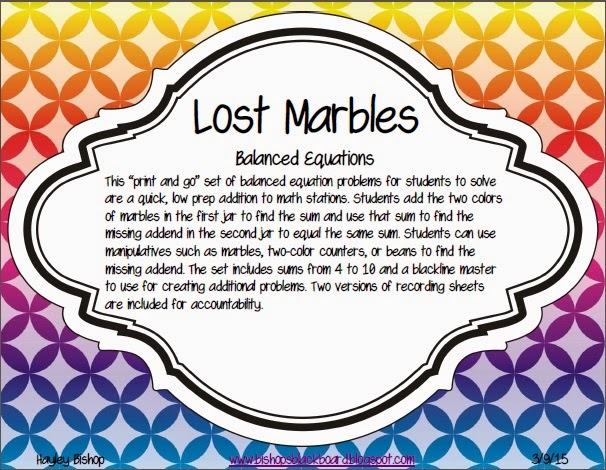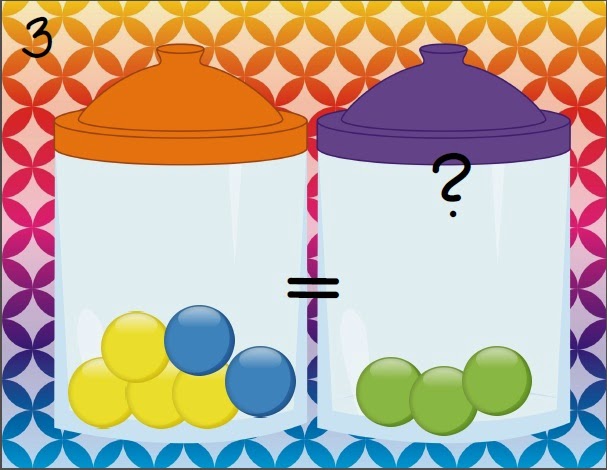Showing posts with label Math. Show all posts
Showing posts with label Math. Show all posts
Monday, March 12, 2018
Base Ten Posters with Expanded Notation
These posters represent numbers to 30 using Base Ten blocks. The posters include the numerical and word from as well the quantity of tens and ones and expanded notation. The posters can also be folded in half to create flashcards. Once they are folded in half, glue the back sides together and laminate. Students can use the pictorial model and record the number of tens and ones and its expanded notation or vice versa.
Place Value Clip Cards with Expanded Notation
This Place Value Clip Card set is meant to be used as independent practice during math stations or during small group tutoring. Students count the Base Ten Blocks and clip the correct expanded notation answer with a clothes pin or paper clip.
Option 1: The students can use the corresponding recording sheet to draw a pictorial model of your card and write the expanded notation.
Option 2: The teacher can add a sticker on the back of the card corresponding to the correct answer so the students can check their own answer.
Option 1: The students can use the corresponding recording sheet to draw a pictorial model of your card and write the expanded notation.
Option 2: The teacher can add a sticker on the back of the card corresponding to the correct answer so the students can check their own answer.
Base Ten Flashcards to 100
- Play “Around the World” to review
- Create a Tree Map to show various ways to represent numbers
- Play “Concentration” to match various ways to represent numbers
- Build numbers using manipulatives
- Order cards from greatest to least, least to greatest
Printable Base Ten Blocks
Several people have asked for Printable Base Ten Blocks to go along with my lesson on creating Place Value Initials. This set includes a printable sheet of tens, ones, and hundreds in black and white.
Place Value Clip Cards
This Place Value Clip Card set is meant to be used as independent practice during math stations or during small group tutoring. Students count the Base Ten Blocks and clip the correct expanded notation answer with a clothes pin or paper clip.
Option 1: The students can use the corresponding recording sheet to draw a pictorial model of your card and write the expanded notation.
Option 2: The teacher can add a sticker on the back of the card corresponding to the correct answer so the students can check their own answer.
Option 1: The students can use the corresponding recording sheet to draw a pictorial model of your card and write the expanded notation.
Option 2: The teacher can add a sticker on the back of the card corresponding to the correct answer so the students can check their own answer.
Place Value Initials Download

Teachers Pay Teachers: Bishop's Blackboard
Check out my store on Teachers Pay Teachers! You will find many general education resources for math, science, and reading along with decorative art items.
Saturday, March 12, 2016
Radial Patterns Station
Kinder through Second Grade students practice creating radial patterns using wooden pattern blocks. Below are some examples of their work:
First Grade Calder Inspired Balloons
First Graders created abstract landscapes with balloons based off of their study of Alexander Calder and his work Balloon 13.
Labels:
2015/2016,
Alexander Calder,
Art,
Artist,
Artist Study,
Artists,
Big Art Day,
First Grade,
Lines,
Math,
Open House,
Primary Colors,
Rulers,
Shapes,
TAEA
Third Grade Alexander Calder Paintings
Third Grade created paintings loosely inspired by artist Alexander Calder. Each student rolled a dice to determine how many circles, wavy lines, and starburst shapes to their work. They then painted the lines black. Once dry, they filled in the rest of the area with primary colors. All of their pieces were displayed together as one large artwork.
Labels:
2015/2016,
Alexander Calder,
Art,
Artist,
Artist Study,
Artists,
Big Art Day,
Games,
Math,
Open House,
Painting,
Primary Colors,
Shapes,
TAEA,
Third Grade
Sunday, January 17, 2016
Third Grade Texture Snowmen
Although the drawings/paintings themselves look simple, the students had to measure and mix tempera paint and baking soda to create a snow-like texture to paint their snowman:
Sunday, September 27, 2015
Second Grade Rockets
Second Grade practiced using a ruler as a tool for measurement when drawing. Each student had to draw a rocket ship that was five inches long. They then added various lines to be the flames. The students colored the rocket ship with crayons and then painted the lines in color wheel order.
Labels:
2015/2016,
Art,
Color,
Color Wheel,
Lines,
Math,
Measurement,
Ruler,
Second Grade,
Space,
Water Colors
Saturday, April 25, 2015
Wayne Thiebaud: Third Grade Popsicles
Third Graders had a mini measurement lesson during our study over artist Wayne Thiebaud. The had to measure four popsicles, two on each side, that were exactly five inches long. As a part of this lesson, we talked about symmetry and repetition. They then worked together to add white to various colors of tempera paint to make lighter tints to paint their popsicles. These were displayed as a part of Open House.
Labels:
2014/2015,
Art,
Art Show,
Artist Study,
Artists,
Color Mixing,
Math,
Measurement,
Open House,
Popsicles,
Repetition,
Symmetry,
Third Grade,
Tints,
Wayne Thiebaud
Friday, April 24, 2015
First Grade Overlapping Candy Canes
First Grade needed some practice back in December on how to draw objects in front of others. So, they practiced by drawing overlapping candy canes. They could make them whatever size and add whatever color patterns they wanted.
Labels:
2014/2015,
Art,
Candy Canes,
Christmas,
First Grade,
Math,
Overlapping,
Patterns,
Repeating Patterns
Monday, March 9, 2015
Lost Marbles Balancing Equations
Although I teach visual arts now, I still create some general education materials by request. I was recently asked to come up with a math station activity for finding balanced equations. So, I came up with the concept of Lost Marbles. This “print and go” set of balanced equation problems for students to solve are a quick, low prep addition to math stations. Students add the two colors of marbles in the first jar to find the sum and use that sum to find the missing addend in the second jar to equal the same sum. Students can use manipulatives such as marbles, two-color counters, or beans to find the missing addend. The set includes sums from 4 to 10 and a blackline master to use for creating additional problems. Two versions of recording sheets are included for accountability. You can download the file from my TpT store.
Labels:
2014/2015,
Addition,
Balancing Equations,
Downloads,
Marbles,
Math,
Math Centers,
Math Stations,
Stations,
TpT
Sunday, October 19, 2014
Cool and Warm Hands: Third Grade
Third Grade students created patterns with geometric shapes and cool/warm colors. To integrate math, students had to find either a square or circle that covered the most area. They traced that shape and then found the same shape but with less area. They traced the shape and then repeated this step until they got to the shape that covered the least area. Once their shapes were traced, they traced their handprint in the middle. They then colored the geometric shapes in a pattern of either warm or cool colors. They colored the handprint in the opposite set of colors. For display, I grouped them into warm and cool colors.
Labels:
2014/2015,
Area,
Art,
Colors,
Cool Colors,
Geometric Shapes,
Handprints,
Math,
Patterns,
Shapes,
Third Grade,
Warm Colors
Sunday, June 1, 2014
Math Fact Celebration
To celebrate the completion of learning our math facts, we had mini ice cream cones for lunch dessert. Each week we focused on a new set of math facts. They did a practice time test on Monday of each week and then the real test on Fridays. Students who had a passing grade, got into a "Math Facts Club" and got to sign their autograph to a poster in the hallway. The posters were a great incentive for the students to work hard to memorize their facts and the ice cream was a special bonus!
Wednesday, May 21, 2014
Name Parts of a Set
To quickly review parts of a set, the students colored their names to sort the vowels and consonants. They then counted how many vowels were in their name out of the whole set and how many consonants out of the whole set. This mini lesson can be found on my TpT store.
Labels:
2013/2014,
Fractions,
Math,
Names,
Parts of a Set,
Teachers Pay Teachers
Measuring Length
The students worked in small groups to measure various objects around the room. They measured with a variety of units including Base Ten Blocks, paper clips, color tiles, etc. They then compared the length of their objects to those of other groups.
Labels:
2013/2014,
Cooperative Learning,
Length,
Math,
Measurement
Subscribe to:
Comments (Atom)


















































































